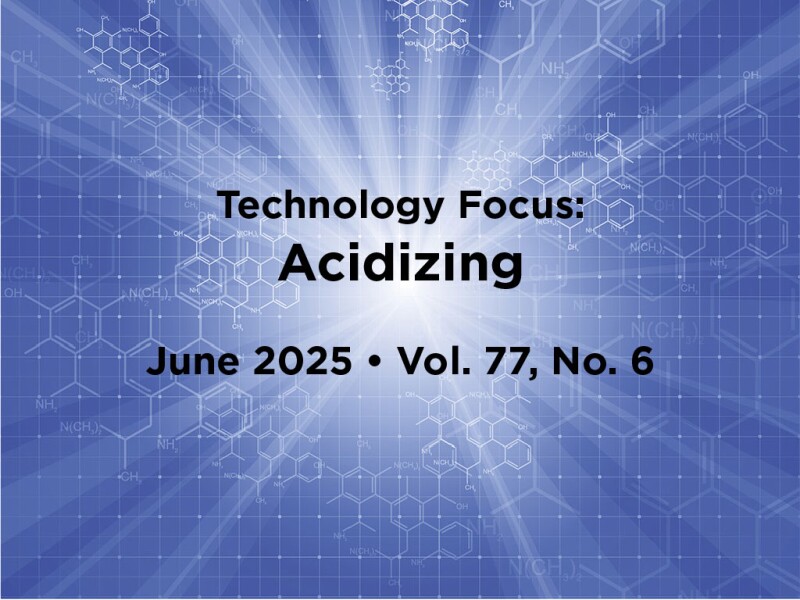This year’s Acidizing feature presents three SPE conference papers that discuss an important battlefront of enhanced production—carbonate reservoirs, those plays whose heterogeneity, reactivity, and flow behavior pose challenges that remain comparatively little-understood, despite the industry’s intensified efforts to maximize their output. Acid stimulation has proved crucial in helping unlock the potential of carbonate reservoirs, and these papers explore ways in which its effectiveness can be sharpened.
Paper SPE 218081 describes a stimulation method deployed in the Montney in which a tool containing a dry chemical is deployed downhole by wireline, initiating an extended exothermic reaction downhole that generates acid vapor at a target depth in front of the perforated interval, allowing each interval to be treated with specific acid blends. In addition to increasing effectiveness of treatment, the method also proved safe and cost-effective.
An integrated two-scale continuum model that contemplates mass, momentum, and energy changes to study the acid-stimulation process in complex carbonate acid-stimulation systems with the development of fracture and vug networks is the focus of paper SPE 222126. Among other findings, the authors write that the presence of fracture and vug networks reduces the consumption of acid fluid required to break through the target core, and that these networks induce the development of wormhole paths within the matrix formation but do not alter the dissolution pattern corresponding to the specific acid-fluid-injection rate.
Finally, in paper SPE 221914, the authors use modeling to demonstrate that autonomous flow-control devices—specifically, autonomous outflow-control devices (AOCDs)—can provide substantial value in stimulation operations, overcoming the challenge posed by carbonates of fairly distributing the acid treatment along the wellbore. They write that AOCDs will show the most benefits through prejob modeling but also react to dynamic changes that may occur along the wellbore, significantly reducing and managing the risks associated with matrix-acidization operations.
Summarized Papers in This June 2025 Issue
SPE 218081 Targeted Acid-Stimulation Technique Enhances Production in the Montneyby Fraser T. Smith, StimStixx Technologies, et al.
SPE 222126 Study Investigates Effect of Fracture and Vug Networks on Acid-Stimulation Process by Cunqi Jia, The University of Texas, et al.
SPE 221914 Autonomous Flow-Control Devices Optimize Matrix Acid Stimulation by Virochan Ganjoo, TAQA, et al.
Recommended Additional Reading
SPE 222015 Experimental Investigation of Degradable Solids Diverter Efficiency for Different Completions Used in Matrix Acid Stimulation by H Zhao, ExxonMobil, et al.
SPE 223002 Novel Density-Controlled Acidizing Approach: Weighted Single-Phase Retarded Acid System in Conjunction With Light-Density Gel Slugs and Fluidic Oscillator Technology Shows a Two-Fold Oil Production Increase and 10% Water-Cut Reduction in a Single Run, Case Study From Iraq by A.S. Masoodi, Halliburton, et al.
SPE 221939 Introduction of Stimulation With Single-Phase Retarded Acid Helps Achieve Superior Results in Highly Depleted Reservoir Newly Drilled Wells Offshore Republic of Congo by V. Mutschler, Perenco, et al.
Chris Carpenter joined SPE in 2001, starting his career as an associate editor and then managing editor of SPE’s peer-reviewed journals. In 2013, he joined the staff of the Journal of Petroleum Technology as technology editor. He is responsible for Technology Focus feature synopses of selected SPE conference papers and is liaison for the JPT Editorial Review Board. He has also served as an adjunct professor of English for several Texas community colleges since 2001. Carpenter holds a BA degree in history from Hendrix College, an MA degree in English from Texas A&M University, and an MFA in writing from the University of Arkansas. He can be reached at ccarpenter@spe.org.

